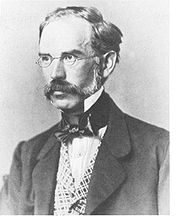
Václav Treitz
Encyclopedia

Bohemia
Bohemia is a historical region in central Europe, occupying the western two-thirds of the traditional Czech Lands. It is located in the contemporary Czech Republic with its capital in Prague...
. He studied medicine in Prague
Prague
Prague is the capital and largest city of the Czech Republic. Situated in the north-west of the country on the Vltava river, the city is home to about 1.3 million people, while its metropolitan area is estimated to have a population of over 2.3 million...
, and performed post-graduate studies in Vienna
Vienna
Vienna is the capital and largest city of the Republic of Austria and one of the nine states of Austria. Vienna is Austria's primary city, with a population of about 1.723 million , and is by far the largest city in Austria, as well as its cultural, economic, and political centre...
with Joseph Hyrtl (1810–1894). Subsequently he practiced medicine at the Jagellonian University in Krakow
Kraków
Kraków also Krakow, or Cracow , is the second largest and one of the oldest cities in Poland. Situated on the Vistula River in the Lesser Poland region, the city dates back to the 7th century. Kraków has traditionally been one of the leading centres of Polish academic, cultural, and artistic life...
, and in 1855 returned to Prague where he became a professor and director of the Pathologic Anatomy Institute.
Throughout his career, Treitz was a figure in the struggle for Czech nationalism. In 1872, at the age of 52, he committed suicide by ingesting potassium cyanide
Potassium cyanide
Potassium cyanide is an inorganic compound with the formula KCN. This colorless crystalline compound, similar in appearance to sugar, is highly soluble in water. Most KCN is used in gold mining, organic synthesis, and electroplating. Smaller applications include jewelry for chemical gilding and...
.
Named structures
Treitz is remembered for his 1853 discovery of the suspensory muscle of the duodenumSuspensory muscle of the duodenum
The Suspensory muscle of duodenum or Ligament of Treitz connects the duodenum of the small intestines to the diaphragm. It contains a slender band of skeletal muscle from the diaphragm and a fibromuscular band of smooth muscle from the horizontal and ascending parts of the duodenum...
(musculus suspensorius duodeni), which was later named the ligament of Treitz. This muscle
Muscle
Muscle is a contractile tissue of animals and is derived from the mesodermal layer of embryonic germ cells. Muscle cells contain contractile filaments that move past each other and change the size of the cell. They are classified as skeletal, cardiac, or smooth muscles. Their function is to...
is a fibrous structure by which the duodenojejunal junction is fixed to the posterior wall of the abdominal cavity. His name is attached to several other anatomical terms, all of which are still valid today:
- Angle of Treitz: sharp curve at the duodenojejenal junction.
- Treitz's arch: (plica paraduodenalis): A fold of peritoneumPeritoneumThe peritoneum is the serous membrane that forms the lining of the abdominal cavity or the coelom — it covers most of the intra-abdominal organs — in amniotes and some invertebrates...
that arches between the left side of the duodenojejunal flexureDuodenojejunal flexureThe duodenojejunal flexure or duodenojejunal junction is the border between the duodenum and the jejunum.The ascending portion of the duodenum ascends on the left side of the aorta, as far as the level of the upper border of the second lumbar vertebra, where it turns abruptly forward to become the...
and the medial border of the left kidneyKidneyThe kidneys, organs with several functions, serve essential regulatory roles in most animals, including vertebrates and some invertebrates. They are essential in the urinary system and also serve homeostatic functions such as the regulation of electrolytes, maintenance of acid–base balance, and...
. - Treitz's fascia: FasciaFasciaA fascia is a layer of fibrous tissue that permeates the human body. A fascia is a connective tissue that surrounds muscles, groups of muscles, blood vessels, and nerves, binding those structures together in much the same manner as plastic wrap can be used to hold the contents of sandwiches...
behind the head of the pancreasPancreasThe pancreas is a gland organ in the digestive and endocrine system of vertebrates. It is both an endocrine gland producing several important hormones, including insulin, glucagon, and somatostatin, as well as a digestive organ, secreting pancreatic juice containing digestive enzymes that assist...
. - Treitz's fossa: subcaecal fossaFossa (anatomy)In anatomical terminology, fossa has come to mean a depression or hollow, in general, in a bone. Other parts of the body may be involved, for example, the antecubital fossa...
, a depression in the peritoneum extending posterior to the caecum. - Treitz's hernia: A duodenojejunal hernia; also known as a retroperitonealRetroperitoneumThe retroperitoneal space is the anatomical space in the abdominal cavity behind the peritoneum. It has no specific delineating anatomical structures...
herniaHerniaA hernia is the protrusion of an organ or the fascia of an organ through the wall of the cavity that normally contains it. A hiatal hernia occurs when the stomach protrudes into the mediastinum through the esophageal opening in the diaphragm....
.

